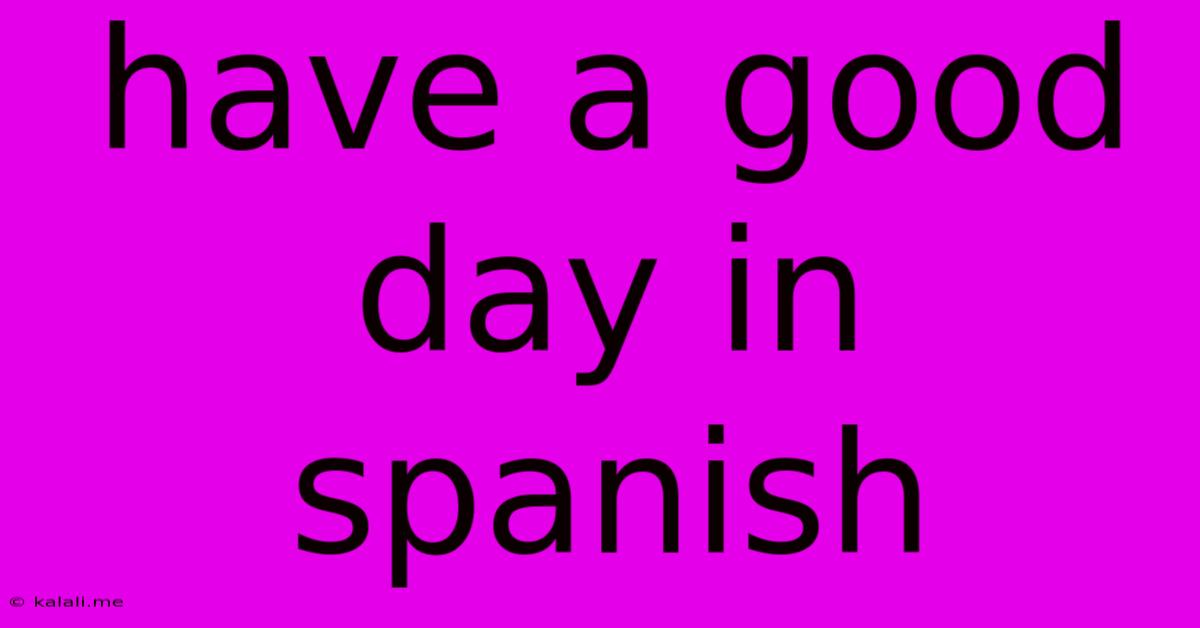Have A Good Day In Spanish
Kalali
May 19, 2025 · 3 min read

Table of Contents
Saying "Have a Good Day" in Spanish: More Than Just "Que Tenga un Buen Día"
Want to wish someone a pleasant day in Spanish? While "Que tenga un buen día" is a perfectly acceptable and widely used phrase, knowing the nuances of Spanish allows for a more natural and expressive greeting. This article dives into various ways to say "have a good day" in Spanish, exploring the subtle differences in formality and context. We'll also cover some regional variations and helpful phrases to enhance your Spanish communication.
Understanding the Context: The best way to say "have a good day" depends on the time of day, your relationship with the person, and the overall setting. A formal greeting won't work well with close friends, and a casual greeting might sound inappropriate in a professional environment.
Formal Greetings: Perfect for Professional Settings
-
Que tenga un buen día: This is the most common and universally understood formal way to say "have a good day." It translates literally to "May you have a good day." It's polite, respectful, and suitable for almost any professional interaction.
-
Que pase un buen día: Similar to the above, this phrase means "May you spend a good day," implying a more prolonged and enjoyable experience. It carries a slightly warmer tone than "Que tenga un buen día."
-
Buenos días: This translates to "Good morning" and is a perfectly acceptable greeting for the morning hours, especially in professional settings. While not strictly "have a good day," it sets a positive tone for the day.
Informal Greetings: Ideal for Friends and Family
-
¡Que tengas un buen día!: Notice the exclamation point! This adds emphasis and warmth, making it perfect for informal settings. It's the informal equivalent of "Que tenga un buen día."
-
¡Qué día tan bonito!: This translates to "What a beautiful day!" It's a great option if the weather is pleasant. It shifts the focus from wishing them a good day to acknowledging the nice day itself.
-
¡Pásalo bien!: This means "Have a good time!" or "Have fun!" It's more suitable for someone who is leaving to do something enjoyable rather than simply going about their day.
Regional Variations and Other Helpful Phrases
Spanish is a diverse language with regional variations. While the phrases mentioned above are widely understood, you might encounter slight differences depending on the country or region. For instance, some speakers might use "tenga" instead of "pase" or add a personal pronoun ("usted" or "tú").
Here are a few additional phrases that can enhance your communication:
-
¡Disfruta del día!: "Enjoy the day!" This is a more enthusiastic and direct way to wish someone well.
-
¡Que te vaya bien!: "Have a good one!" or "Take care!" This is a more concise and casual farewell, often used amongst close friends.
-
Hasta luego: "See you later," a versatile phrase that can be used in both formal and informal settings.
-
Hasta mañana: "See you tomorrow," perfect for saying goodbye at the end of the day.
Mastering the art of saying "have a good day" in Spanish goes beyond simple translation. Understanding the nuances of formality, context, and regional variations will make your interactions more authentic and engaging. So choose the phrase that best suits the situation, and spread some Spanish sunshine!
Latest Posts
Latest Posts
-
Look Forward To Talk To You
May 19, 2025
-
Can I Use Caster Sugar Instead Of Icing Sugar
May 19, 2025
-
Another Way Of Saying This Is Because
May 19, 2025
-
On A Train Or In A Train
May 19, 2025
-
How To Answer How Do You Do
May 19, 2025
Related Post
Thank you for visiting our website which covers about Have A Good Day In Spanish . We hope the information provided has been useful to you. Feel free to contact us if you have any questions or need further assistance. See you next time and don't miss to bookmark.